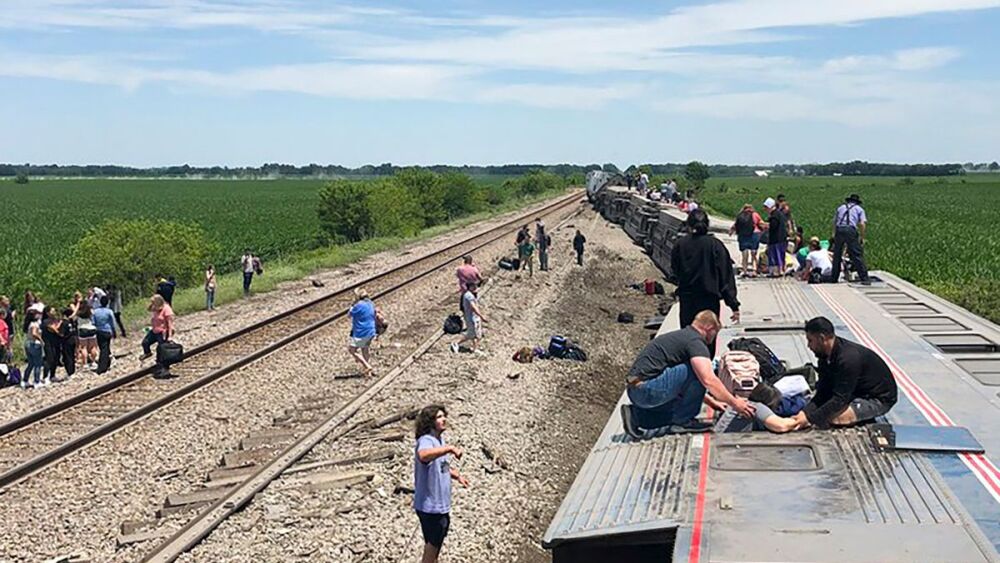What happened
An Amtrak train carrying approximately 255 passengers and crew struck a dump truck in an uncontrolled intersection in Chariton County, Missouri, near Mendon, killing four and injuring dozens more Monday, June 27, 2022.
Why it’s significant
At a press conference late Monday, Missouri State Highway Patrol Troop B Public Information Officer Cpl. Justin Dunn confirmed that three people had died in the collision, one occupant in the dump truck and two on the train as of Monday night. He emphasized that this was an early and ongoing investigation involving multiple agencies.
A statement released by Amtrak noted the Southwest Chief train was traveling from Los Angeles to Chicago with eight cars, including one for luggage, and it derailed after striking a truck that was obstructing a public crossing. Amtrak activated its Incident Response Team and deployed emergency personnel to the scene to help support passengers, employees and their families.
Emergency units were dispatched just after 12:43 p.m. for a reported crash involving a train southwest of Mendon, according to the highway patrol.
At 1:02 p.m., emergency units began to arrive at the scene and confirmed the dispatch information: a dump truck struck by a train at an uncontrolled crossing on a rural, gravel road, according to Dunn.
Following are the top considerations for a response of this magnitude.
1. Mutual aid
Mendon has a population of approximately 160 is northeast of Kansas City.
EMS agencies from eight jurisdictions and air medical support transported the injured from the scene of the incident.
Fire departments, EMS agencies and law enforcement from nearly 20 local and state offices responded.
Takeaway: Fire, EMS agencies on all levels should train and practice mass causality incidents and coordinate nearby local agencies. These incidents happen in metro and rural settings.
2. Extrication
The McDonald family, traveling on an annual trip to see family in Fort Madison, was onboard the train and spoke exclusively with EMS1.
“We were in the second-to-last train car. I was sitting next to my sister and my brother was across from us with our mother,” passenger Samantha McDonald (21) told EMS1. “We heard this loud bang. I went flying to the other side of the train car. My sister thankfully landed on the seats. I landed on the overhead bins.”
Samantha told me the passengers in their train car helped each other extricate themselves from the wreckage. She noted many passengers onboard the train were asleep when the crash occurred.
“We had to crawl 10 feet up the side of the train. There wasn’t a top escape hatch,” Samantha explained. “My sister has very poor mobility. We had to get four people to lift her out of the train and local farmers came with ladders to get us down off the train.”
Takeaway: Accidents involving trains and other commercial vehicles can be challenging, not only because of the amount of casualties, but because of the specialty resources needed to extricate these patients. Patients involved in high-speed collisions with trains, planes and buses could have more severe injuries complicating extrication.
3. Transportation
As part of the triage plan for the incident, passengers able to walk were transported by school buses to the Northwestern High School gymnasium.
“The buses drove out to the tracks and we filed in,” Samantha told me. “After stopping at the school, I was then transported by bus to the Moberly Regional Medical Center.”
According to Samantha, she was one of 35 people on her bus that required medical evaluations.
“There were three or four buses that went to the hospital,” she added.
For those more seriously injured, according to Cpl. Dunn, “each ambulance was transporting multiple victims.”
Takeaway: Plan for transportation at different triage levels. Know what resources you have around you and be able to contact them in an emergency.
What happens next
Samantha McDonald, traveling with her sister, mother and brother Dax (26), escaped the incident with minor injuries. Samantha was the only family member to be transported to the hospital for evaluation.
Photos and videos showing the inside of the train car taken by Dax have been published by the Associated Press and show baggage thrown about inside the train car. They also show the passengers rallying together to assist either other.
The McDonald family wants to express how thankful they were to escape the incident and how nice the hospital staff was.
Samantha added that this was her first train ride. The family decided to take the train as a cheaper option to visit her grandparents.
“We thought we would take the train for the experience. And an experience it was,” Samantha said.
This accident will be part of an investigation to see how it could have been avoided and how rescue operations could be improved. Training and planning for all emergency services is key in these types of situations.
Learn more
Learn more about MCI triage and transportation with these resources:













